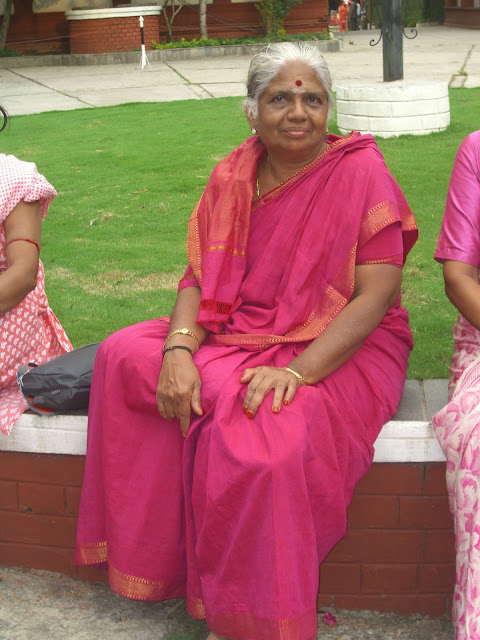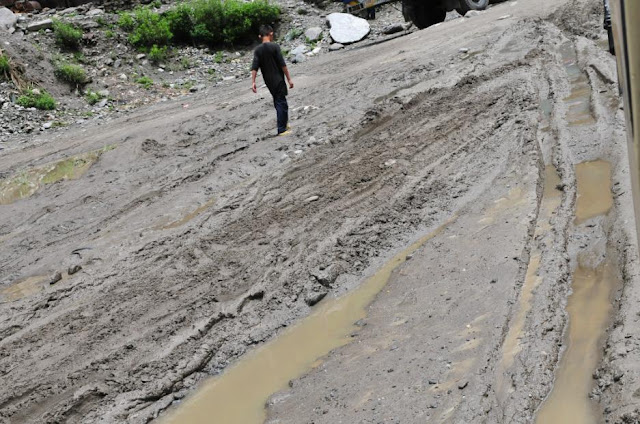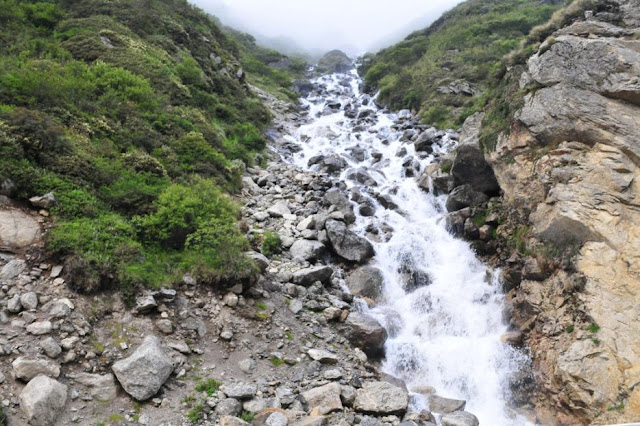Mallik and I did not go to the Shiva temple of Pashupatinath at 4 am, as we had hoped to do for many weeks in Dallas.
This was the day of the first morning
pooja - worship ceremony, at 7. Wore
salwar-kameez and did not know it then, but the next time that I was to wear
salwar-kameez again would be on the last day of the trip, back at Kathmandu, fourteen days later. Which basically means, I had a few sets of
salwar-kameez in my duffel bag that were never used. :) My recommendation to travelers - you only need mountain gear in Tibet.
 |
| Morning pooja in Kathmandu (Sairam's collection) |
 |
| Amma, waiting to leave for the temple |
The group trip to the temple of Pashupatinath started at 9 in the morning, after a heavy breakfast. Private citizens are allowed to perform rituals in the sanctum sanctorum of the 12 main temples of Shiva in India, the
Jyotirlingas. At the temple of Pashupatinath in Kathmandu - the only Shiva temple in the world equivalent to, or even higher than the
Jyotirlingas, only the temple priests are currently allowed to set foot in the sanctum sanctorum. I would not get to perform the
rudrabhishek - the worship ritual that I have been performing at the
Jyotirlingas. So be it. But after standing in line for half an hour, when I finally got a glimpse of the deity, the priest asked me -
pooja karni hai? - do you want to perform the worship ritual? The face of that priest is etched in my mind - I sometimes get this feeling that Shiva has come to me as people who have helped me along the way, probably my reaction to Jim Carrey's character in Bruce Almighty never recognizing God.
The priest had to ask me twice because I was not sure this was happening. After I nodded yes, he collected all the pooja material from within the temple - the coconut, milk, yogurt, honey, sugar, ghee, fruit, nuts,
bilwa leaves, flowers, garland,
rudraaksh necklace, water, lamp, plate, and the list goes on. For each step of the pooja, he would ask me to touch things that he would then take to the deity and perform the rituals, and finally, he asked me to perform the
aarti - the final ritual to end the worship ceremony. I know there were security guards and other temple volunteers very loud and actively keeping the line moving. I am not sure what happened during the time that I stood at one spot, performing the
pooja - it should have been a good 20 minutes or more. I was too engrossed and heard nothing till the priest gave me the
rudraaksh necklace and also the coconut, sugar cubes and fruit, that had been offered to the deity. It was exactly six months to the day Anish, Ash and I had performed the
rudrabhishek at the Mahakaleshwar temple in Bhopal after the
bhasma-arti - the worship ritual with ashes. Perfect start to a perfect day and a good sign for a perfect trip!!
It was June 26, a full-moon day, and also the day of the first lunar eclipse of 2010 - a partial eclipse was to be viewed from some parts of the world. For those who know far more than I do about the import of the lunar calendar, today was
Jyeshtha Poornima - the full moon day in the Hindu month of
Jyeshtha. From the little I know,
Ashad, the fourth month of the Hindu calendar would now begin, per the north Indian Hindu calendar - an auspicious month for worship ceremonies and pilgrimages. Per the calendar from south India that the Swamijis follow, the second-half of the month of
Jyeshtha had started, the fortnight of the waning moon. A fortnight later, we would have completed our trip and I would be in Ahmedabad in time for the
rath yatra - the chariot ride, for the divine Krishna and siblings, that takes place two days after the new moon in the month of
Ashad.
The statue of Nandi, the bull, outside the temple of Pashupatinath is gigantic. The face of Nandi has a look of longing and ecstasy as it looks at the temple - Mallik and I both noticed that emotion on the bull's face, my regards to the unnamed sculptors who built this for the millions of piligrims to visit through the centuries. No pictures, my camera equipment was in the hotel, and I now recall everything from memory.
In the temple campus, they had opened up a hitherto-closed section where there are 108 Shivalingas. Behind the temple are the ghats, - the banks of the river Baghmati. As I looked down from the temple and saw the water, I did not understand what I was looking at, till Kalpakkam-ji pointed out a cremation in progress. And then I saw two more bodies waiting in line. This is the first temple I have seen where funerals can be seen from the temple premises.
Adi Shankara re-established Sanatana Dharma, called Hinduism by the Persians and later by the rest of the world, more than two milleniums ago as the mainstream faith practice in India when the population was getting divided into sects and sub-sects, and getting lost in rituals without the knowledge-seeking activity that is essential to sustaining Dharma. I see his lifetime of 32 years as a bright light in the midst of the blackness and mist of the centuries. He renounced worldly life at the age of 8, learned from gurus, and spread the word of Dharma. He established
Advaita as the dominant school of philosophy in Sanatana Dharma.
Advaita is the philosophy of non-duality (of the nature of
Brahman, the supreme consciousness). He traveled the length and breadth of Aryavrata, what is currently the Indian sub-continent and re-vitalized countless temples and re-established Vedic practices.
In remote temples, I have always been humbled by the presence of Adi Shankara's
padchihna, - footprints. These ancient temples for which I book flights, cars, drivers, porters and ponies, were visited by Adi Shankara on foot at a tender age many centuries ago - in Badrinath where Adi Shankara dove to the exact spot in the river to retrieve the idol of Vishnu as he had seen in his dream, in Joshimath where he meditated in a cave for several years, in Kashmir where he re-established the worship at the Shiva temple outside Srinagar, Kedarnath at 12K ft in the lower Himalayas where I have so far felt closest to Shiva and where Shankara re-established worship and ultimately passed away there. And now I was hoping to see Kailash where I would hopefully experience
Dakshinamoorthy as described by Adi Shankara - the glory of the formless Shiva imparting knowledge in silence as the students sit in quiet contemplation. The highly complex philosophy of
Advaita cannot be taught, it has to be experienced - repeated chanting of the
Dakshinamoorthy stotram is an aid to this experience for the students of
Advaita.
In the temple complex of Pashupatinath, there is an Adi Shankara temple as well, and oddly, there was a cow standing on the temple steps. I tickled the cow quite a bit, I missed Snowy so much. Snowy's role in our Dallas household is to increase awareness and affection for the animal kingdom. We believe she was a cow in her previous life who has taken this birth just so she can wag her tail and lick people. From Adi Shankara to Snowy in 2 seconds, such is the attention span of people like me that the Swamijis have to deal with.
 |
| Rudraksh and other purchases at the store outside Pashupatinath temple |

At a store near the temple, people went crazy buying perfect-looking
rudraaksh - prayer beads. It is the seed of an evergreen tree that grows in the Himalayan region in India and Nepal. There are many varieties, I have no ability to recognize genuine
rudraaksh, and these beads looked too perfect to be natural products. My concern was not that I would waste money, it was that I already had lots of
wannabe-rudraksh at home.
Last year, at the Sandeepani ashram in Bhopal, as I was leaving the Shiva temple, a man sitting in the sanctum sanctorum had offered me a single
rudraaksh bead which he explained was exceptional - I forget the reasons, I am quite sure he was cashing in on my naivete. I looked around for Anish to pay up, but he had already left the temple. I looked into my purse and all I had was 1000-INR notes. Surely, the man expected much less. After a moment's hesitation, I gave him 1000 INR. It did not feel right to ask for change back while standing inside a Shiva temple and receiving
rudraaksh. And as of today, I had the rudraksh garland from the priest at Pashupatinath. I did end up buying 3 basic
rudraaksh garlands - after Srihari suggested I could buy garlands and dip them in the Manas Sarovar waters - one for us at Dallas, one for my parents and one for my parents-in-law.
 |
| Stupa in Kathmandu (Sairam's collection) |
Our next stop was a Buddhist
stupa. The intolerable June heat of Kathmandu did not allow us to enjoy much. It was a hurry-scurry around the
stupa, talk a bit and rush to the bus that had fans that did not work. Hopefully, if the bus moved quickly enough, there would be a breeze.
 |
| Vishnu lying on a bed of snakes in cosmic waters, Budhanilkantha temple (Yoga's collection) |
The last stop was the temple of Jal Narayana or sleeping Vishnu, better known as the Budhanilkantha temple. It has a striking statue of Vishnu, the benefactor aspect of the Divine, lying on a bed of snakes in cosmic waters. Legend has it that the royal family of Nepal is cursed not to see this idol of Vishnu, else it will destroy the family. And local rumor has it that the massacre of the Nepali royal family in 2001 by the crown prince Dipendra was caused by his visit to this temple in his college days.
After lunch at the hotel, Mallik and I made a trip to the temple of Bhadrakali, the destroyer-of-evil form of the Divine Mother. There is a definite Asian influence in the building, as seen by the sculpture of the lions that surround this little temple. The maintenance of the temple appears to be done by a family who lives close by, there were children scrubbing and cleaning the whole time that we were there. Right after Mallik and I had completed our worship and came out of the temple, there was a quick and heavy downpour for about two to three minutes and just as people ran for cover, it stopped as suddenly as it had started. Both of us had the same thought - that somebody had showered blessings on us. It is the best day of my life, a visit to the most holy Shiva temple in the world and a visit to an ancient Bhadrakali temple on the same day - Jun 26, 2010.
 |
| Bhadrakali temple, Kathmandu |
We went shopping in Kathmandu's shopping area, Thamil, to buy T-shirts to give as gifts to the Sherpas and the porters. Another recommendation: we found T-shirts for INR 150-200 in Nepal, but if I had known this earlier, I would have bought better ones from home, and would have saved an hour that I spent searching for T-shirts in Kathmandu. I had wanted to visit the palace of the virgin goddess that I did not have time to go to.
 |
| Marketplace, Thamil, Kathmandu |
We had our first
satsang - discourse, this evening, quite short with most of the time taken up by
bhajan - hymn singing by assorted people. In my humble opinion, singing hymns helps the mind focus on a deity. It is not my experience that it uplifts me spiritually. Listening to songs and music does rest me physically by sometimes putting me to sleep as Anish discovered after I slept through a classical music concert for which he had purchased premier seating. He goes alone to music events since then, and I respect that. :) A lady singing in Tamil was an amazing singer, she sounded like a recording - even my tone deaf ears could figure that, I understood not a thing except that she was a devout worshiper. Actual intellectual debate would clarify my understanding of subjects. With six swamijis, I was hoping I get to hear a couple of days' words of wisdom from each.
And after a super-heavy dinner with the sweet yogurt, finally it was 10pm. We had to turn in all bags including my veteran international bags. My roomie Kalpakkam-ji - worrying and careful - is the perfect complement to my I-can-handle-anything-and-manage-everything attitude. She lives in Phoenix, and she had joined the Dallas group for this trip. We had to furiously pack everything into the duffel bags we have been given. I am glad I did not bring the $$$ duffel bag and the $$$ back pack we had bought earlier, I would have looked like a Saks commercial in this sea of basic bright red pizza-box-carrier duffel bags and bright red I-love-kindergarten backpacks.
I sent my last e-mail to Anish and Ash, my parents and my in-laws, saying I will be leaving Kathmandu the next morning, and will catch up with them when I get back. Swamiji had told me that one's life had to be sinless to find a final resting place in Kailash, the conclusion being - no worries about my dying there. I fully agree with the evaluation but I have hope. One day my ashes will be sprinkled on the Himalayas, why not take the body when I am bringing it there?
Aum Namah Shivaaya!!






























 At a store near the temple, people went crazy buying perfect-looking rudraaksh - prayer beads. It is the seed of an evergreen tree that grows in the Himalayan region in India and Nepal. There are many varieties, I have no ability to recognize genuine rudraaksh, and these beads looked too perfect to be natural products. My concern was not that I would waste money, it was that I already had lots of wannabe-rudraksh at home.
At a store near the temple, people went crazy buying perfect-looking rudraaksh - prayer beads. It is the seed of an evergreen tree that grows in the Himalayan region in India and Nepal. There are many varieties, I have no ability to recognize genuine rudraaksh, and these beads looked too perfect to be natural products. My concern was not that I would waste money, it was that I already had lots of wannabe-rudraksh at home.

